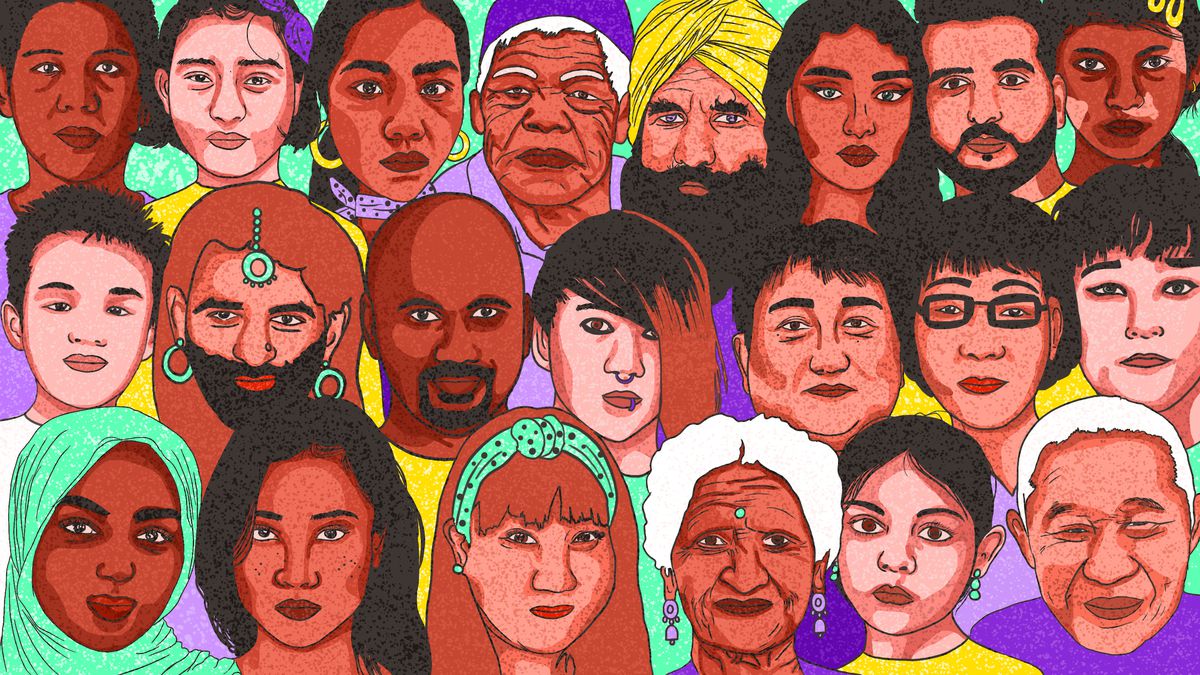The above illustration is a work by Hanifa Abdul Hameed,created for a Vox article.
America’s changing racial demographics raise new questions about mass politics in the U.S. One of the more vexing involves the partisan allegiances of Asian Americans and Latinos who, together, comprise the two fastest-growing segments in our nation’s population. Some headlines portray two populations with zig–zagging attachments to either Democrats and Republicans, as evidenced by notable shifts among some Asian and Latino adults in their votes for Democratic and Republican contenders in recent years. If true, this would imply two massive pan-ethnic groups whose partisan identities are malleable and still up for grabs. But our multi-year research effort reveals precisely the opposite: Asian Americans and Latinos are stalwart partisans, with robust levels of attachment to Democrats (or Republicans) that hardly move in an appreciable way—even during Donald Trump’s turbulent, nativist 2017-2021 presidency when pressures to change partisan allegiances were arguably at a peak.
The primary challenges to drawing firm conclusions about the partisan attachments of Asian Americans and Latinos revolve around data. When we read about dramatic breaks in the partisanship of these individuals, we have a weak sense of their starting point: how did they identify before—and by how much did their allegiance reliably change, if at all? Polls can shift from year to year because voters’ attitudes shift, but also because the people responding to the polls may shift. Answering such a simple question entails assessing people’s baseline levels of partisanship and then following the same people over time to track any changes—preferably during times when American politics is in flux. This is exactly what we did beginning in 2016 when Donald Trump eventually emerged as the Republican nominee for president of the United States.
In spring 2016, we asked a population-based sample of Asian American (N=721) and Latino (N=820) adults to report their level of partisan identification. To this end, we used a standard 7-point scale, where 1 indicates a “strong Democrat”, a 4 indicates pure “independents,” and a 7 indicates “Strong Republican”—with various degrees of partisanship recorded in between these values. This initial reading shows that Latinos who interviewed in Spanish are the most heavily Democratic group, averaging 2.38 on our 7-point scale. Latino and Asian adults who interviewed in English are also Democratic identified, albeit to a lesser degree, registering 3.07 and 3.17 on our partisanship scale. By the time we reassessed partisanship two years later, deep into the Trump presidency, we find the hallmarks of stable partisanship—Asian Americans and Latinos still trended in a pro-Democratic direction, with statistically negligible changes of less than 1/3 of a point on our 7-point scale.
Of course, even in the face of this stability, some Asian Americans and Latinos did change their degree of self-identification as Democrats (or, less commonly, as Republicans). Given the nativist candidacy and presidency of Donald Trump, two leading explanations emerge for explaining changes in partisan identity among these groups. One perspective is that the salience of immigration politics—and its implications for two immigrant-heavy populations, like Asian Americans and Latinos—shaped these groups’ sense of attachment to their preferred party. Another related perspective is that Trump’s racially charged rhetoric and policy actions guaranteed that Asian Americans’ and Latinos’ sense of pan-ethnic identification as Asian American or Latino drove such changes. Using conventional measures of attitudes toward immigration and pan-ethnic identification from 2016, we predicted the change in Asian and Latino partisanship reflected in 2018. We find that neither immigration attitudes nor pan-ethnic identity shaped changes in partisanship, thus further underlining the stability of Asian and Latino partisan identities.
This non-pattern seems to fly in the face of many people’s intuitions about the role of pan-ethnic identity in the early era of Donald Trump. With such an overtly nativist stance during his campaign and administration, it stands to reason that Asian American and Latino identities shaped those groups’ degree of partisanship, right? To figure this out, we undertook another analysis in which 1) we predicted Asian and Latino partisanship in fall 2018 on the basis of their pan-ethnic identity in fall 2016; and 2) we predicted pan-ethnic identity among Asian and Latino adults in fall 2018 based on their partisan identity in fall 2016. This cross-lagged analysis, as it is technically known, lets us observe whether one’s previous level of pan-ethnic identity structures one’s current degree of partisanship—or whether one’s previous partisanship level impacts one’s current sense of pan-ethnic identity. The results of this test suggest that partisanship shapes one’s pan-ethnic identity, not the other way around. Once we account for 2016 levels of pan-ethnic identity, knowing the strength of Asians’ and Latinos’ partisanship in that year allows us to better predict these groups’ degree of identification as Asian Americans and Latinos. Partisanship is so stable that it can affect our respondents’ sense of being Asian American and Latino, respectively. That echoes research on other identities.
Our data suggest that political efforts to capture the Asian American and Latino vote are more complicated than politicians might assume. False assumptions of partisan malleability might lead politicians to pander toward these groups and shallowly politicize salient current events, rather than address long-standing, meaningful issues that gave rise to partisanship in the first place.
This blog piece is based on forthcoming the Journal of Politics article “The Surprising Stability of Asian Americans’ and Latinos’ Partisan Identities in the Early Trump Era” by Daniel Hopkins, Cheryl Kaiser and Efren Perez, volume 85, number 4.
You can read the research article on the JOP website. The empirical analysis of this research has been successfully replicated by the JOP and replication files are available in the JOP Dataverse.
About the Authors
Daniel Hopkins is a Professor in the Political Science Department at the University of Pennsylvania whose research centers on American politics, with a special emphasis on racial and ethnic politics, state/local politics, political behavior, and research methods. For more information visit his website and follow him on Twitter:@dhopkins1776
Cheryl R. Kaiser is a Professor in the Department of Psychology at the University of Washington whose research examines the interplay between social psychological theoretical perspectives and social issues. Much of her research examines the self and social identity; particularly from the perspective of members of socially marginalized groups. For more information visit her website follow her on Twitter: @cherylrkaiser
Efrén Pérez is Full Professor of Political Science and Psychology at UCLA, where he directs its Race, Ethnicity, Politics, and Society (REPS) Lab and co-directs its Intergroup Relations (IRL) Lab. Efrén draws on psychological principles to better understand the political attitudes and behaviors of racial and ethnic groups in the United States, especially people of color. For more information visit her website and follow her on Twitter: @EfrenPoliPsy




